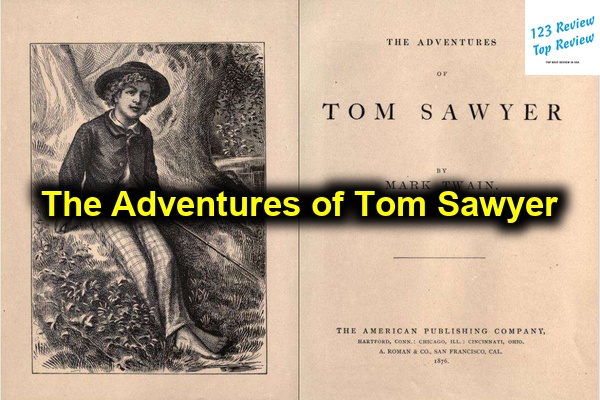The novel follows the escapades of a young boy, Tom Sawyer, as he grows up along the banks of the Mississippi River in the fictional town of St. Petersburg, Missouri. Through Tom’s adventures, twists, and companionship with friends, Twain deftly explores critical themes related to childhood, friendship, society, and morality.

In this article, 123 Review will provide an in-depth literary analysis, examine its reception and impact, draw comparative perspectives with other literary works, and share personal insights, culminating in overall impressions of its lasting legacy.
Literary Analysis of The Adventures of Tom Sawyer
Themes Explored in The Adventures of Tom Sawyer
One of the most compelling aspects of The Adventures of Tom Sawyer is the variety of themes Twain weaves into the narrative, each reflecting different facets of life and childhood. Below, we delve into some of these key themes in detail.
Childhood and Innocence
At its core, Tom Sawyer is a celebration of childhood. Twain captures the joys and freedoms associated with being a child through the lens of Tom’s adventures. Tom embodies the spirit of youth—curious, mischievous, and imaginative. The innocence of children is portrayed vividly in scenes where Tom and his friends—Huck Finn, Joe Harper, and others—engage in adventure, exploration, and make-believe.
The novel illustrates the boundless imagination that characterizes childhood, as seen when Tom and Huck fantasize about being pirates on an island. Twain creates vivid scenarios where the boys escape their mundane lives to explore their fantasies, highlighting how children navigate their reality through imagination. This theme resonates with readers, allowing adults to reflect on their own childhood experiences filled with innocence and joy.
Friendship and Loyalty
The bond of friendship is another significant theme in The Adventures of Tom Sawyer. The friendship between Tom and Huck Finn is central to the narrative and serves as a vehicle for exploring themes of loyalty, trust, and camaraderie. Their relationship evolves throughout the story, with each character influencing the other’s decisions and moral growth.
Tom’s unwavering loyalty to Huck during their adventures—culminating in the heart-pounding climax of witnessing the murder in the graveyard—shows the depth of their bond. Even when faced with moral dilemmas, Tom prioritizes their friendship, illustrating that loyalty often comes with personal sacrifice.
Moreover, the novel portrays the values of support and companionship as crucial to navigating childhood. The characters come together in times of trouble and laughter, reinforcing the idea that true friends stand by each other through thick and thin. The portrayal of friendship echoes throughout literature, making it a relatable experience for readers of all ages.
Social Class and Society
Twain provides a critical examination of social class in The Adventures of Tom Sawyer. St. Petersburg’s society is stratified, with distinct divisions between the wealthy and the poor. Tom’s interactions with various characters—ranging from children like Becky Thatcher to the affluent artists and adults—underscore this class divide.
Huck Finn, who comes from a poor background, represents this theme as a social outcast. Huck’s struggles are emblematic of societal attitudes toward class and poverty, highlighting Twain’s critiques of his contemporary society. Through Huck’s viewpoint, readers get insights into the harsh realities of social stratification, prejudice, and the inherent value society often errs in placing on individuals based on their economic status.
Twain’s portrayal of Tom and Huck’s adventures provides a satirical commentary on the moral failings of adults in positions of power and their inability to protect or understand children from different social backgrounds. This exploration makes the narrative not only a light-hearted tale of childhood but also a poignant critique of societal norms.
Rebellion and Conformity
Tom Sawyer is a character defined by his rebellion against societal norms and expectations. His antics—whether sneaking out to go to his own funeral or running away to become a pirate—reflect a spirited resistance to the constraints imposed by adults. Twain’s portrayal of Tom’s rebellion can be contextualized within the broader American zeitgeist of the 19th century, a time marked by growing individualism and a questioning of traditional authority.
Tom’s defiance is noteworthy in scenes where he refuses to adhere to the expectations of school. Rather than submitting to authority, he cleverly finds ways to manipulate his teachers and peers, highlighting the theme of childhood autonomy. However, while Tom embodies the spirit of rebellion, he also learns the importance of responsibility and consequences throughout the story, indicating a balance between freedom and societal obligations.
Race and Prejudice
Though The Adventures of Tom Sawyer primarily centers on childhood adventures, underlying themes of race and prejudice emerge, particularly through Huck Finn’s character and journey. Twain subtly addresses stereotypes and societal attitudes toward race, reflecting the social realities of the time. The interactions between characters reveal deeply entrenched racial prejudices within the community.
Huck’s relationship with Jim, a runaway slave, is a cornerstone of this theme. As Huck grapples with societal teachings about race and his morality, their friendship challenges his previously held beliefs. The narrative illustrates the tension between the innocence of childhood friendships and the societal prejudices that threaten to fragment them, setting the stage for Huck’s moral evolution that continues in The Adventures of Huckleberry Finn.
Character Development in The Adventures of Tom Sawyer
Twain’s characters are not only vivid and memorable but also undergo significant development that adds depth to the story. We will explore key characters and their development throughout the narrative.
Tom Sawyer
Tom Sawyer, the eponymous character, begins the story as a self-centered, impulsive boy seeking adventure and excitement. However, as the plot unfolds, Tom’s character evolves considerably. His initial need for attention and glory transforms into a deeper understanding of love, loyalty, and responsibility.
Throughout the novel, Tom displays moments of bravery, especially in the face of danger—such as when he testifies in court to protect Jim. These moments reflect Tom’s growing awareness of morality and the implications of his actions beyond seeking self-fulfillment. His love for Becky Thatcher also illustrates a gradual maturation, as he learns to navigate complex emotions, jealousy, and apology.
Ultimately, Tom serves as a bridge between childhood innocence and the dawning realities of adulthood, representing the complexities of growing up within societal structures.
Huckleberry Finn
Huck Finn serves as a foil to Tom, representing a different perspective on childhood and morality. Huck is portrayed as more pragmatic and independent, having to navigate a world that is often unkind. His adventures with Tom are characterized by a sense of freedom and exploration, reflective of his status as an outcast.
As Huck navigates various moral dilemmas, particularly regarding his relationship with Jim, he undergoes a profound transformation. His internal struggle highlights the conflict between societal expectations and personal ethics. Huck ultimately decides to prioritize his friendship with Jim over societal norms, as famously encapsulated in the moment when he declares he would “go to hell” rather than betray Jim.
Huck’s character growth, from a carefree boy to a morally conscious individual, sets the foundation for the themes explored in The Adventures of Huckleberry Finn. His journey reflects Twain’s critique of a society built on racial prejudices and a flawed moral compass, offering readers a lens into the complexity of navigating morality.
Becky Thatcher
Becky Thatcher, Tom’s love interest, embodies the complexities of young romance. Initially depicted as a delicate and sometimes petty child, Becky’s character evolves throughout the narrative. She transitions from a position of power, leveraging her status over Tom, to experiencing vulnerability and hurt as their relationship faces challenges.
Through her interactions with Tom—such as her jealousy towards Amy Lawrence—Becky demonstrates the insecurities and youthful passions that characterize early romantic experiences. However, as the story develops, she learns valuable lessons about forgiveness and the importance of empathy in relationships. In particular, her conflicting emotions during the treasure hunt scene highlight her growth as she shifts from selfishness to a more profound understanding of loyalty and support.
Aunt Polly, Tom’s guardian, serves as the maternal figure who adds depth to Tom’s background. Her strict yet caring demeanor reflects the traditional role of women in society. Her love for Tom remains constant; however, her attempts to instill morality in him often conflict with his rebellious spirit. Aunt Polly’s character represents the societal expectations placed on adults as guardians of morality.
Writing Style and Narrative Techniques
Mark Twain’s writing style in The Adventures of Tom Sawyer is distinctive, incorporating humor, local color, and dialect to create an authentic representation of life along the Mississippi River. His narrative techniques enhance the storytelling experience, immersing readers in the world of Tom Sawyer.
Humor and Satire
Twain’s wit pervades every page, infusing the narrative with humor that entertains while simultaneously providing social critique. His use of satire becomes apparent through exaggerated situations and colorful characters, allowing Twain to comment on the absurdities he observes in society.
For example, the famous episode of Tom convincing his peers to whitewash a fence not only offers comedic relief but also satirizes the notions of labor and the glorification of hard work. This scene reveals how children can manipulate situations to their advantage and highlights societal norms regarding work and leisure.
Through delightful anecdotes and situations, Twain makes insightful observations about human behavior, revealing the folly and hypocrisy often present in adult society. This humor serves as an inviting entry point for readers of all ages to engage with the deeper themes woven throughout the narrative.
Dialect and Regional Language
One of Twain’s most notable achievements in The Adventures of Tom Sawyer is his use of regional dialects, which adds authenticity and vibrancy to the characters and setting. Twain’s meticulous attention to the dialects and vernacular speech of the time allows readers to hear the distinct voices of characters, such as Tom, Huck, and Aunt Polly.
For instance, the dialogue spoken by the children captures the playful yet often naïve conversations inherent to childhood. The regional language enhances the tale’s realism while offering insights into the culture and values of the time. Twain’s commitment to accurately portraying regional speech elevates the novel beyond mere storytelling, allowing readers to immerse themselves in life in St. Petersburg.
First-Person Perspective and Immersion
Although The Adventures of Tom Sawyer is primarily narrated in the third person, Twain occasionally slips into a first-person perspective, which provides a unique connection to characters. This technique allows readers to experience moments of introspection, deepening empathy for Tom’s thoughts and feelings as he navigates various adventures and moral dilemmas.
Additionally, Twain’s use of vivid imagery and detailed descriptions of the Mississippi River and its surrounding landscape creates an immersive atmosphere. From the freedom and excitement of a summertime adventure to the oppressive heat of a Southern day, Twain’s descriptive language enables readers to visualize and experience the world Tom inhabits.
Imagery and Description
Twain’s rich imagery captures not only the physical setting but also the emotional undercurrents of the narrative. The contrast between the beauty of the river and the complexities of societal life reflects the duality of childhood innocence versus the harsh realities of adulthood. Vivid descriptions of sunsets, the texture of dirt roads, and the vibe of a summer day enrich the narrative, enhancing readers’ involvement in Tom’s escapades.
The imagery surrounding the river serves dual purposes. It depicts the freedom Tom and Huck long for, as well as the dangers they encounter. Specific scenes that showcase the boys floating down the river or fishing reflect a child’s dream of play and exploration—themes quintessential to childhood and adventure.
Symbolism and Motifs in The Adventures of Tom Sawyer
Twain skillfully employs symbolism and motifs throughout The Adventures of Tom Sawyer, adding layers of meaning to this seemingly simple story. These elements enrich readers’ understanding of the characters and themes.
The Mississippi River
The Mississippi River stands as one of the novel’s most prominent symbols, connoting both freedom and adventure. For Tom and Huck, the river embodies a place of escape from the constraints of their lives. Its flowing waters symbolize the spirit of adventure, while also foreshadowing the dangers associated with the unknown.
When Tom and Huck run away to the river to live as pirates, they temporarily shed the responsibilities and expectations of the adult world. The river serves as a powerful backdrop against which they can imagine their lives filled with freedom and joy. However, as their adventures unfold, the river also becomes a site of conflict and moral decision-making, emphasizing that freedom carries with it inherent risks.
The Whitewashed Fence
The iconic scene of Tom tricking his friends into painting a fence serves as a multifaceted symbol. Initially, the act of whitewashing represents the burdens of labor and societal expectations. However, Tom’s clever manipulation transforms this mundane task into a game, exposing the characteristics of childhood ingenuity and resourcefulness.
This episode exposes social commentary about labor and the value of work. Tom’s ability to turn punishment into an enjoyable activity reflects the cleverness and wit of boyhood, reinforcing the notion that children can find joy and creativity in even the most mundane tasks.
Treasure and Buried Gold
Treasure is a recurring motif throughout the novel, epitomizing the quest for adventure and dreams of wealth. Tom and Huck’s aspirations to find buried gold serve as a metaphor for childhood fantasy and the notion of success. The excitement that accompanies their treasure hunts is representative of the desires and dreams intrinsic to youth.
However, the elusive nature of treasure also symbolizes the disillusionment that accompanies growing up. Tom and Huck discover that the thrill of treasure gives way to the reality of responsibility and moral decisions, mirroring the transition from childhood innocence to adulthood.
Piracy and Adventure
Throughout the story, Tom and Huck fantasize about being pirates, a motif that embodies the desire for freedom and adventure. This idea of piracy allows them to escape societal constraints, leading to moments of great imagination and camaraderie.
By envisioning themselves as pirates, the boys reclaim a sense of control over their lives, defying adult authority. However, as their adventures reveal the complexities of real-life situations, the notion of piracy also serves as a reminder of the harsh realities that accompany adulthood, challenging the idyllic innocence that defines their childhood.
Reception and Impact
Critical Acclaim of The Adventures of Tom Sawyer
Upon its release, The Adventures of Tom Sawyer garnered attention and praise from critics and readers alike. Twain’s unique storytelling style, imaginative characters, and humor resonated with audiences, establishing the novel as a classic of American literature. While the book received some criticism for its portrayal of childhood antics and societal issues, its overall impact was profoundly positive.
Many praised Twain for his ability to depict childhood with authenticity, humor, and sensitivity. Critics recognized the novel’s intricate character development and the multi-dimensional relationships between characters as strengths that added depth to the narrative. The humor and satire embedded in the tale were particularly appreciated, providing a clever exploration of society through the lens of childhood experiences.
Historical Context of The Adventures of Tom Sawyer
Set in the early to mid-19th century, The Adventures of Tom Sawyer reflects the sociocultural and historical dynamics of the time. Twain captures the essence of small-town America along the Mississippi River, allowing readers to immerse themselves in a world less affected by industrialization than by river life and individualism.
The novel’s timing coincides with significant societal changes in America, including issues of race, class, and gender roles. By placing Tom within a society grappling with these changing dynamics, Twain subtly critiques the social constructs of his time. While the world is presented through the lens of childhood innocence, it brushes against the complexities of race relations and the realities faced by individuals like Huck Finn.
In particular, Twain’s exploration of childhood is contemporaneous with a growing interest in the concept of childhood itself—a period considered separate from adulthood, characterized by innocence and exploration. This shift in societal perspective is reflected in Twain’s literature, making it not only an entertainment piece but also a reflection of emerging social consciousness.
Influence on American Literature
The literary influence of The Adventures of Tom Sawyer extends far beyond its initial publication, shaping subsequent generations of writers and poets. Twain’s exploration of childhood, society, and morality paved the way for future American literature that examined individual experiences against the backdrop of broader societal issues.
Writers such as F. Scott Fitzgerald, Ernest Hemingway, and William Faulkner have cited Twain’s impact on their work, particularly in regard to how they portray character development and thematic elements. More contemporary authors look to Twain’s use of humor and regional dialect in their writing, illustrating the enduring nature of his style.
Additionally, Twain’s ability to capture the complexities of youth in the face of societal norms continues to resonate with readers today. The Adventures of Tom Sawyer remains a touchstone in American literary discussions, recognized for its contributions to the evolving narrative of American identity and experience.
Comparative Perspectives
Comparison with The Adventures of Huckleberry Finn
The Adventures of Huckleberry Finn, published in 1884, is often considered a sequel and companion piece to The Adventures of Tom Sawyer. While both novels share a focus on childhood adventures, Huckleberry Finn delves deeper into social issues and moral dilemmas.
Whereas Tom Sawyer emphasizes light-hearted mischief and the joys of youth, Huckleberry Finn prompts readers to confront serious themes such as racism, injustice, and ethical conflicts. In Huckleberry Finn, Huck grapples with his conscience as he contemplates helping Jim, a runaway slave, leading to profound moral questions.
The contrast between Tom’s innocent escapades and Huck’s difficult moral decisions exemplifies Twain’s evolution as a writer. It marks a transition from whimsical storytelling to addressing the weight of social realities. Their contrasting journeys present a multifaceted view of childhood, inviting readers to reflect on their development and the impact of societal norms on morality.
Adaptations and Interpretations of The Adventures of Tom Sawyer
The Adventures of Tom Sawyer has inspired numerous adaptations across various media forms, including films, television shows, and stage productions. These adaptations offer unique interpretations of Twain’s work, often modifying elements to resonate with contemporary audiences while striving to capture the essence of the original story.
Some of the notable film adaptations include:
- Tom Sawyer (1973): An animated musical adaptation that highlights the novel’s whimsical aspects through music and colorful illustrations, appealing to younger audiences.
- The Adventures of Tom Sawyer (1995): A live-action film featuring Jonathan Taylor Thomas as Tom. This adaptation modernizes certain elements while maintaining the core narrative of childhood adventure and mischief.
- The Adventures of Tom Sawyer (2000): A musical adaptation produced for television, showcasing the narrative’s humor and imagination while bringing the story to new audiences.
These adaptations often emphasize the themes of adventure and friendship while simplifying or altering specific social commentaries to suit contemporary tastes. Despite variations in presentation, the core of Twain’s narrative—exploring childhood, moral dilemmas, and social critique—remains prevalent.
The popularity of the story continues to permeate pop culture through variations in theatrical productions, educational adaptations, and modern retellings. The dependability of The Adventures of Tom Sawyer as both entertaining and educational ensures the story remains relevant across generations.
Reader Insights
Personal Reflections on The Adventures of Tom Sawyer
Reflecting on The Adventures of Tom Sawyer invites a sense of nostalgia for childhood simplicity and the innocent joys of youth. Through Twain’s narrative, readers can reconnect with memories of exploration, friendship, and boundless imagination—elements that resonate deeply long after childhood has passed.
The character of Tom Sawyer embodies the spirit of adventure and unrestrained freedom that many adults yearn for in their own lives, creating a sense of longing as readers envision their carefree youth. This connection to childhood experience emphasizes the emotional depth woven throughout Twain’s storytelling.
Furthermore, the interactions between Tom and Huck encapsulate the enduring nature of friendship—one that is steadfast even through challenges and changes. Adults often reflect on similar dynamics in their own lives, reinforcing the idea that loyalty and support are essential aspects of meaningful relationships.
Lessons and Morals Derived from The Adventures of Tom Sawyer
Several essential lessons can be gleaned from The Adventures of Tom Sawyer, many of which continue to resonate in contemporary discussions about childhood and morality:
- Value of Friendship: The bond between Tom and Huck underscores the fundamental importance of friendship. Their unwavering loyalty to each other serves as a powerful reminder of the strength and support that characterize true companionship.
- Importance of Imagination: Twain encourages readers to embrace their imagination and creativity, rooted in the spirit of childhood exploration. The escapades of Tom and Huck illustrate how play allows for personal growth and discovery.
- Moral Growth and Responsibility: Tom’s evolving moral compass highlights the importance of taking responsibility for one’s actions. His character development illustrates that growing up involves navigating the complexities of right and wrong, often highlighting the importance of compassion and understanding over societal expectations.
- Critique of Societal Norms: Twain invites readers to question societal expectations and prejudices through Tom’s misadventures. The story serves as a vehicle for critiquing moral and ethical complexities, encouraging readers to think critically about their beliefs and values.
Audience Reception Over Time
Over the decades, The Adventures of Tom Sawyer has garnered significant attention and readership. Early reviews highlighted its humor, heartwarming moments, and rich character development, celebrating it as an enduring classic.
As societal perspectives have evolved, modern critiques of the novel have emerged, focusing on its portrayal of race, gender, and societal dynamics. These critiques invite readers to engage in deeper discussions about the historical context of the work and its relevance in contemporary society.
Despite these critical interpretations, the novel continues to be a staple in educational settings, prized for its exploration of childhood, friendship, and personal growth. Its status as a classic ensures that new generations of readers experience Tom’s adventures while grappling with the multilayered themes that define the story.
Conclusion and Final Thoughts
Overall Impression of The Adventures of Tom Sawyer
The Adventures of Tom Sawyer stands as a testament to Mark Twain’s masterful storytelling, blending humor, social critique, and authentic character development into an unforgettable tale. Twain’s exploration of childhood innocence, rebelliousness, and moral complexities resonates profoundly.
The heartwarming depictions of adventure, friendship, and self-discovery make it an essential read for both children and adults. Twain’s ability to navigate the difficulties of youth while offering critiques of societal norms elevates the narrative beyond entertainment, inviting readers to reflect on their experiences.
Lasting Legacy of The Adventures of Tom Sawyer
The legacy of The Adventures of Tom Sawyer endures as it continues to inspire readers and writers alike. Its exploration of childhood themes, societal critique, and the powerful bonds of friendship solidify its place as a seminal work in American literature.
As readers engage with Tom’s journey and the adventures of the characters, Twain’s insights into humanity remain impactful, affirming that the joys and struggles of childhood are both timeless and universally relatable. In a rapidly changing world, The Adventures of Tom Sawyer serves as both a nostalgic reflection and a critical examination of the values that shape our lives, ensuring its relevance for generations to come. As we celebrate Twain’s literary contribution, we recognize that the magic of Tom Sawyer will endure, along with its lessons about innocence, friendship, and the nuances of growing up.





